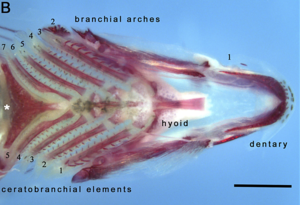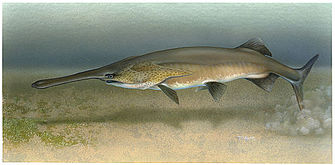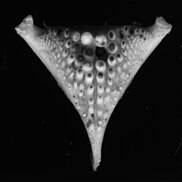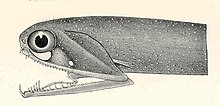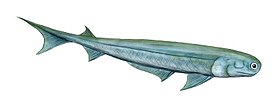Fish jaw
Most
Jaws probably originated in the
Jaws use
Skull
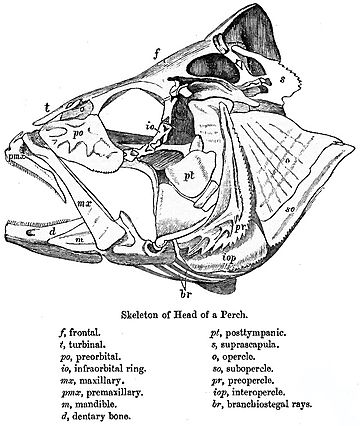
The
The simpler structure is found in
In
Although the skulls of fossil lobe-finned fish resemble those of the early tetrapods, the same cannot be said of those of the living lungfishes. The skull roof is not fully formed, and consists of multiple, somewhat irregularly shaped bones with no direct relationship to those of tetrapods. The upper jaw is formed from the pterygoids and vomers alone, all of which bear teeth. Much of the skull is formed from cartilage, and its overall structure is reduced.[9]
Oral jaws
Lower

In vertebrates, the lower jaw (
This complex primitive pattern has, however, been simplified to various degrees in the great majority of vertebrates, as bones have either fused or vanished entirely. In
Upper
The upper jaw, or maxilla[12][13] is a fusion of two bones along the palatal fissure that form the upper jaw. This is similar to the mandible (lower jaw), which is also a fusion of two halves at the mandibular symphysis. In bony fish, the maxilla is called the "upper maxilla," with the mandible being the "lower maxilla". The alveolar process of the maxilla holds the upper teeth, and is referred to as the maxillary arch. In most vertebrates, the foremost part of the upper jaw, to which the incisors are attached in mammals consists of a separate pair of bones, the premaxillae. In bony fish, both maxilla and premaxilla are relatively plate-like bones, forming only the sides of the upper jaw, and part of the face, with the premaxilla also forming the lower boundary of the nostrils.[14] Cartilaginous fish, such as sharks and rays also lack a true maxilla. Their upper jaw is instead formed from a cartilagenous bar that is not homologous with the bone found in other vertebrates.[14]
Some fish have permanently protruding upper jawbones called
- Fish with rostrums (extended upper jawbones)
-
Theelectroreceptors
-
Sawfish have an electro-sensitive rostrum (saw) which is also used to slash at prey
Jaw protrusion
The premaxilla is unattached to the neurocranium (braincase); it plays a role in protruding the mouth and creating a circular opening. This lowers the pressure inside the mouth, sucking the prey inside. The lower jaw and maxilla (main upper fixed bone of the jaw) are then pulled back to close the mouth, and the fish is able to grasp the prey. By contrast, mere closure of the jaws would risk pushing food out of the mouth. In more advanced teleosts, the premaxilla is enlarged and has teeth, while the maxilla is toothless. The maxilla functions to push both the premaxilla and the lower jaw forward. To open the mouth, an adductor muscle pulls back the top of the maxilla, pushing the lower jaw forward. In addition, the maxilla rotates slightly, which pushes forward a bony process that interlocks with the premaxilla.[17]
Teleosts achieve this jaw protrusion using one of four different mechanisms involving the ligamentous linkages within the skull.[18]
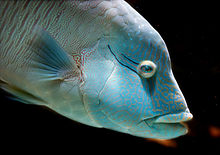
- Mandibular depression mechanism: The depression of the lower jaw (mandible) pulls or pushes the premaxilla into protrusion via force transmission through ligaments and tendons connected to the upper jaws (e.g. Cyprinus, Labrus).[18] This is the most commonly used mechanism.
- Twisting maxilla mechanism: The depression of the mandible causes the maxilla to twist about the longitudinal axis resulting in the protrusion of the premaxilla (e.g. Mugil).[18]
- Decoupled mechanism: Protrusion of the premaxilla is accomplished through elevation of the neurocranium causing the premaxilla to move anteriorly. Movements of the neurocranium are not coupled with the kinematics of the upper jaw (e.g. Spathodus erythrodon),[18][19] allowing for more versatility and modularity of the jaws during prey capture and manipulation.
- Suspensorial abduction mechanism: The lateral expansion of the suspensorium (a combination of the palatine, pterygoid series, and quadrate bones) pulls on a ligament which causes the premaxilla to protrude anteriorly (e.g. Petrotilapia tridentiger).[18][19]
Some teleosts use more than one of these mechanisms (e.g. Petrotilapia).[18]
Wrasses have become a primary study species in fish-feeding
The nasal and mandibular bones are connected at their posterior ends to the rigid neurocranium, and the superior and inferior articulations of the maxilla are joined to the anterior tips of these two bones, respectively, creating a loop of 4 rigid bones connected by moving joints. This "four-bar linkage" has the property of allowing numerous arrangements to achieve a given mechanical result (fast jaw protrusion or a forceful bite), thus decoupling morphology from function. The actual morphology of wrasses reflects this, with many lineages displaying different jaw morphology that results in the same functional output in a similar or identical ecological niche.[20]
The most extreme jaw protrusion found in fishes occurs in the
Pharyngeal jaws

A notable example occurs with the moray eel. The pharyngeal jaws of most fishes are not mobile. The pharyngeal jaws of the moray are highly mobile, perhaps as an adaptation to the constricted nature of the burrows they inhabit which inhibits their ability to swallow as other fishes do by creating a negative pressure in the mouth. Instead, when the moray bites prey, it first bites normally with its oral jaws, capturing the prey. Immediately thereafter, the pharyngeal jaws are brought forward and bite down on the prey to grip it; they then retract, pulling the prey down the moray eel's gullet, allowing it to be swallowed.[23]
All vertebrates have a pharynx, used in both feeding and respiration. The pharynx arises during development through a series of six or more outpocketings called
Cartilaginous jaws
This gives these areas much of the same strength found in the bony tissue found in other animals.Generally sharks have only one layer of tesserae, but the jaws of large specimens, such as the bull shark, tiger shark, and the great white shark, have two to three layers or more, depending on body size. The jaws of a large great white shark may have up to five layers.[26] In the rostrum (snout), the cartilage can be spongy and flexible to absorb the power of impacts.
In sharks and other extant
Teeth
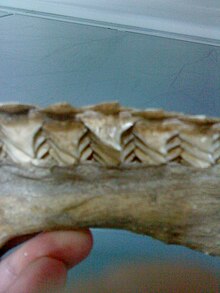
Jaws provide a platform in most
While both
Tooth shape depends on the shark's diet: those that feed on
- Cartilaginous jaws and their teeth
-
Jaw reconstruction of the extinctCarcharodon megalodon, 1909
-
The thornback ray has teeth adapted to feed on crabs, shrimps and small fish.
-
The shortfin mako shark lunges vertically and tears flesh from prey
-
Tiger shark teeth are oblique and serrated to saw through flesh
-
The prickly shark has knife-like teeth with main cusps flanked by lateral cusplets
Examples
Salmon

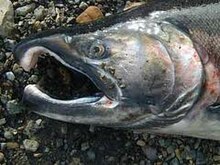
Male
Cichlids

Fish jaws, like vertebrates in general, normally show
In cichlids generally, the oral and pharyngeal teeth differ with different species in ways that allow them to process different kinds of prey. Primary oral jaws contain teeth which are used to capture and hold food, while pharyngeal jaws have pharyngeal teeth which function as a chewing tool.
This allows for different nutritional strategies, and because of this, cichlids are able to colonize different habitats. The structural diversity of the lower pharyngeal jaw could be one of the reasons for the occurrence of so many cichlid species. Convergent evolution took place over the course of the cichlid radiation, synchronous with different trophic niches.[48] The pharyngeal jaw apparatus consists of two upper and one single lower plate, all of which have dentations that differ in size and type.[49] The structure of the lower pharynx is often associated with the species of food of the species.[50]
In order to crack shellfish considerable force must be generated, which is why cichlids that feed on molluscs (e.g. the cichlid bass, Crenicichla minuano), have molariform teeth and a strengthened jawbone bone. To grab and bite prey not armoured with shells, predators need conical, bent back teeth.[51] Herbivorous cichlids also have structural differences in their teeth. Cichlids that specialise in algae (e.g. Pseudotropheus) tend to have small conical teeth. Species that feed on pods or seeds require large conical teeth for chewing their food.[52]
Other
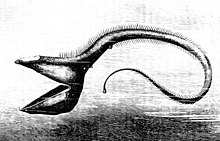
Stoplight loosejaws are small fish found worldwide in the deep sea. Relative to their size they have one of the widest gapes of any fish. The lower jaw has no ethmoid membrane (floor) and is attached only by the hinge and a modified tongue bone. There are several large, fang-like teeth in the front of the jaws, followed by many small barbed teeth. There are several groups of pharyngeal teeth that serve to direct food down the esophagus.[53][54]
Another deep sea fish, the pelican eel, has jaws larger than its body. The jaws are lined with small teeth and are loosely hinged. They open wide enough to swallow a fish larger than the eel itself.
Distichodontidae are a family of fresh water fishes which can be divided into genera with protractile upper jaws which are carnivores, and genera with nonprotractile upper jaws which are herbivores or predators of very small organisms.[55]
Evolution
The appearance of the early vertebrate jaw has been described as "a crucial innovation"
The customary view is that jaws are
It is now accepted that the precursors of the jawed vertebrates are the long extinct bony (armoured) jawless fish, the so-called
Placoderms were a
The original selective advantage offered by the jaw may not be related to feeding, but rather to increased respiration efficiency.
Jaws are thought to derive from the
See also
- Cranial kinesis
- DLX gene family
- Entelognathus primordialis
- Glossohyal
- Gnathostomata (jawed vertebrates)
- Hox gene
- Hyomandibula
- Palatoquadrate
References
- ^ PMID 19215146.
- PMID 17263894.
- PMID 19849854.
- ^ .
- ^ ISBN 978-0-8133-3807-1.
- ^ S2CID 46933606.
- PMID 29237766.
- PMID 8927640.
- ^ a b c d Romer & Parsons 1977, pp. 173–177
- ^ The mandible is also in some sources still referred to as the inferior maxillary bone, though this is an outdated term which goes back to at least the 1858 first edition of Gray's Anatomy, if not earlier.
- ^ a b c Romer & Parsons 1977, pp. 244–247
- OED2nd edition, 1989.
- ^ "maxilla". Merriam-Webster Online Dictionary.
- ^ a b Romer & Parsons 1977, pp. 217–243
- PMID 22401891.
- PMID 21676723.
- ISBN 978-1-4051-4449-0.
- ^ JSTOR 1445030.
- ^ .
- ^ PMID 21676769.
- ^ Chisholm, Hugh, ed. (1911). . Encyclopædia Britannica. Vol. 28 (11th ed.). Cambridge University Press. p. 839.
- S2CID 46933765.
- S2CID 4384411.
- PMID 23020903.
- OCLC 39217534.
- ^ Martin, R. Aidan. "Skeleton in the Corset". ReefQuest Centre for Shark Research. Retrieved 21 August 2009.
- S2CID 45227734.
- PMID 21672820.
- ISBN 978-1-4398-3924-9.
- PMID 21693066.
- ^ Loesche, Max (1 October 2020). "Do Carp Have Teeth? (Interesting Fish Facts)". Strike and Catch. Retrieved 25 August 2022.
- PMID 19215146.
- PMID 18625062.
- ^ Dave Abbott, Sharks, found here
- S2CID 34954175.
- PMID 2606790.
- PMID 16351980.
- PMID 32533826.
- PMID 16450392.
- S2CID 201732743.
- ^ "How big are whale sharks? And four other whale shark facts". World Wildlife Fund. Retrieved 25 August 2022.
- ^ "Basking Sharks". Basking Shark Scotland. Retrieved 25 August 2022.
- PMID 14635799.
- ISBN 978-0-7748-0359-5.
- ^ PMID 22970282.
- S2CID 33113282.
- PMID 20102595.
- S2CID 18363916.
- S2CID 46927413.
- S2CID 15963069.
- .
- S2CID 13285836.
- S2CID 1038874.
- .
- ISBN 978-0-471-25031-9.)
{{cite book}}: CS1 maint: multiple names: authors list (link - ^ Benton 2005.
- PMID 11523812.
- ISBN 978-0-253-34926-2.
- S2CID 56425436.
- ^ For example: (1) both sets of bones are made from neural crest cells (rather than mesodermal tissue like most other bones); (2) both structures form the upper and lower bars that bend forward and are hinged in the middle; and (3) the musculature of the jaw seem homologous to the gill arches of jawless fishes. (Gilbert 2000)
- ^ Gilbert (2000). Evolutionary Embryology.
- S2CID 33913758.
- PMID 16701387.
- S2CID 43389789.
- ^ "Placodermi: Overview". Palaeos. Retrieved 10 December 2014.
- ^ "Acanthodii". Palaeos. Retrieved 10 December 2014.
- ^ "More About Placoderms". Devonian Times. 9 July 2005. Archived from the original on 6 March 2018. Retrieved 9 December 2014.
- ^ "Ancient Fish With Killer Bite". Science News. 19 May 2009. Archived from the original on 29 September 2012. Retrieved 2 December 2014.
- ISBN 978-1-84028-152-1.
- ^ "Monster fish crushed opposition with strongest bite ever". The Sydney Morning Herald. 30 November 2006.
- ^ PMID 17443970.
- ^ S2CID 86203770.
- ^ "More About Acanthodians (spiny fins)". Devonian Times. 9 July 2005.
- ISBN 978-0-521-57011-4.
- ^ Britt, Robert Roy (28 November 2006). "Prehistoric Fish Had Most Powerful Jaws". Live Science.
- ^ a b "The Gill Arches: Meckel's Cartilage". palaeos. Retrieved 4 December 2014.
Further reading
- ISBN 978-1-4051-4449-0.
- Botella, H.; Blom, H.; Dorka, M.; Ahlberg, P. E.; Janvier, P. (2007). "Jaws and teeth of the earliest bony fishes". Nature. 448 (7153): 583–586. S2CID 4337868.
- Compagnucci, C; Debiais-Thibaud, M; Coolen, M; Fish, J; Griffin, J N; Bertocchini, F; Minoux, M; Rijli, F M; Borday-Birraux, V; Casane, D; Mazanc, S; Depew, M J (2013). "Pattern and polarity in the development and evolution of the gnathostome jaw: Both conservation and heterotopy in the branchial arches of the shark, Scyliorhinus canicula". Developmental Biology. 377 (2): 428–448. PMID 23473983.
- Depew, M J; Lufkin, T; Rubenstein, J L (2002). "Specification of jaw subdivisions by Dlx genes". Science. 298 (5592): 381–385. S2CID 10274300.
- Forey, Peter; Janvier, Philippe (2000). "Agnathans and the origin of jawed vertebrates". In ISBN 978-0-226-28497-2.
- Gilbert, Scott F. (2000). "The anatomical tradition: Evolutionary Embryology: Embryonic homologies". Developmental Biology. Sunderland (MA): Sinauer Associates, Inc. (NCBI). Retrieved 9 April 2018. (3rd and 4th paras, One of the most celebrated cases...)
- Hulsey, CD; Fraser, GJ; Streelman, JT (2005). "Evolution and development of complex biomechanical systems: 300 million years of fish jaws". Zebrafish. 2 (4): 243–257. PMID 18248183.
- Koentges, G; Matsuoka, T (2002). "Jaws of the fates". Science. 298 (5592): 371–373. S2CID 20212436.
- Lingham-Soliar, Theagarten (2014). "The First Vertebrates, Jawless Fishes, the Agnathans". The Vertebrate Integument Volume 1. pp. 11–31. ISBN 978-3-642-53747-9.
- Lingham-Soliar, T. (2014). "The Earliest Jawed Vertebrates, the Gnathostomes". The Vertebrate Integument. Vol. 1. Springer. pp. 33–58. ISBN 978-3-642-53748-6.
- Mallatt, J. (2008). "The origin of the vertebrate jaw: Neoclassical ideas versus newer, development-based ideas". Zoological Science. 25 (10): 990–998. S2CID 3104126.
- Mehta, Rita S.; Wainwright, Peter C. (May 2008). "Functional morphology of the pharyngeal jaw apparatus in moray eels". Journal of Morphology. 269 (5): 604–619. S2CID 17013964.
- Muschick, M.; Salzburger, W. (2013). "Pharyngeal jaws and their evolutionary, ecological and behavioural significance" (PDF). In Muschick, Moritz (ed.). Convergence and plasticity in the adaptive radiation of cichlid fishes (PhD thesis). University of Basel. pp. 13–37.
- Oisi, Y; Ota, K G; Kuraku, S; Fujimoto, S; Kuratani, S (2013). "Craniofacial development of hagfishes and the evolution of vertebrates". Nature. 493 (7431): 175–180. S2CID 4403344.
- Romer, Alfred Sherwood; Parsons, Thomas S. (1977). The Vertebrate Body. Philadelphia, PA: Holt-Saunders International. ISBN 978-0-03-910284-5.
- Soukup, V; Horácek, I; Cerny, R (2013). "Development and evolution of the vertebrate primary mouth". Journal of Anatomy. 222 (1): 79–99. PMID 22804777.
- Wainwright, P. C. (2006). "Functional Morphology of the Pharyngeal Jaw Apparatus". In Shadwick, R. E.; Lauder, G. V. (eds.). Fish Biomechanics. Fish Physiology. Vol. 23. Academic Press. pp. 77–102.
- Westneat, M. W. (2006). "Skull Biomechanics and Suction Feeding in Fishes". In Shadwick, R. E.; Lauder, G. V. (eds.). Fish Biomechanics. Fish Physiology. Vol. 23. Academic Press. pp. 29–76. ISBN 978-0-08-047776-3.
- Westneat, Mark W. (2004). "Evolution of levers and linkages in the feeding mechanisms of fishes". Integrative and Comparative Biology. 44 (5): 378–389. PMID 21676723.
External links
| External videos | |
|---|---|
- "Moray Eels Are Uniquely Equipped to Pack Big Prey Into Their Narrow Bodies" (Press release). National Science Foundation. 5 September 2007.
- Myers, PZ (13 March 2007). "Evolution of the jaw". Pharyngula.
- Barford, Eliot (25 September 2013). "Ancient fish face shows roots of modern jaw". News. Nature.
- Zhu, Min; Yu, Xiaobo; Erik Ahlberg, Per; Choo, Brian; Lu, Jing; Qiao, Tuo; Qu, Qingming; Zhao, Wenjin; Jia, Liantao; Blom, Henning; Zhu, You'an (2013). "A Silurian placoderm with osteichthyan-like marginal jaw bones". S2CID 4462506.


